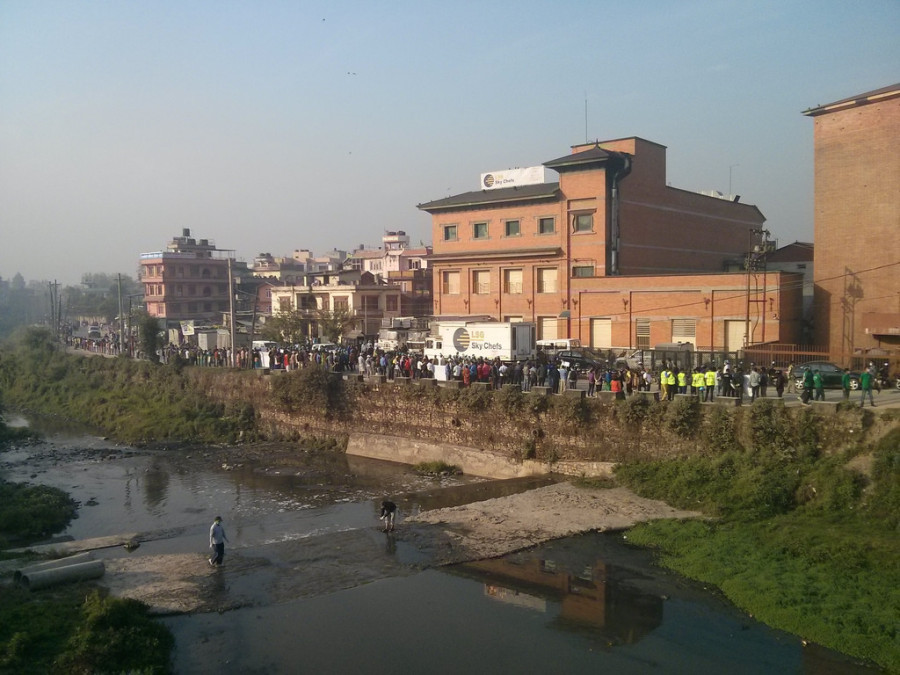Opinion
Full steam ahead
If the community comes together, Bagmati river could return to its former glory
Tsewang Nuru Sherpa
One of the repercussions of Kathmandu’s rapid transformation and urbanisation is the valley-wide reduction of green spaces, which has invited a slew of major environmental problems like land and water pollution. The Bagmati River captures the extent to which the city has been marred by pollution.
The largest river in the capital city, which once served as a major water source, has sadly degraded into a filthy and pungent sewer. Beyond just serving as a source of sustenance, the river also historically holds religious, economic and symbolic significance. Yet only a surviving few in the valley are able to recount its status as a healthy flowing river. Today, due to unplanned urbanisation, disposal of untreated sewage and solid waste and governmental oversight, it has deteriorated almost beyond repair. In addition, extractions of sand from the river bed, construction of public infrastructure in and around the river space, and illegal settlements along the banks have deteriorated the river environment and water security.
In order to address these key issues and improve the natural environment along the Bagmati river, the High-Powered Committee for Integrated Development of the Bagmati Civilisation (HPCIDBC) has been working as one of the project implementers for the Bagmati River Basin Improvement Project (BRBIP) project. The main focus area of HPCIDB is to work on the beautification of the Bagmati river from Gokarana until Sinamangal. Project-related activities include removing contaminated riverbed material through the construction of the river training wall, constructing weirs and providing phytoremediation to enhance the river’s self-cleaning capacity.
The project also aims at building a green belt along the river banks to promote a separate track for bicycles and pedestrians, which will reduce both traffic congestion and air pollution. The inter-scepter sewerage construction also aims to divert the polluted water from entering the main river. The Bagmati River Park along the river stretch has also been intentionally designed to foster the growth of vegetation. The Park aims to make urban greening along the river banks denser, so that the river serves as a green corridor. By re-establishing the natural aquatic habitat, the park aims to serve as a much-
needed green lung for the city. In addition to this, the park aims at mobilising, raising awareness about environmental issues, and building the capacities of local governments and communities for riverbank management and maintenance. Through these efforts, the project hopes to cultivate a sense of ownership over the bagmati river and its surrounding areas.
It has been around nine years since the project was implemented. However, it’s clear that much more work is required. The ongoing cleaning campaign launched and sustained by its promoters is very laudable. But the amount of solid waste is increasing despite it.
And recently, the fish species in the Bagmati River that lived in the clean water above Guheshwori have started dying as pollution prevails in the river yet again.
The rising numbers of settlers and squatters have also contributed to the river’s dilapidated state. In addition to the severe encroachment of land, the settlements also encourage improvised manual sand mining and direct disposal of excreta and solid waste.
The squatter settlement has not only imposed disturbances on sustainable land management, but has also obstructed the Bagmati River Beautification Project. According to data published by the Nepal Landless Democratic party in 2017, there are around 29,00 landless people that have encroached Kathmandu Valley’s river banks. The BRBIP project has been disturbed by the squatter settlements; only 7.2 km stretch of river banks from Gokarna until Sinamanghal have been under project construction.
The major challenge facing the proper implementation of the river basin project is to ensure the ownership of the river by the local people. Until locals and stakeholders do not take responsibility in contributing to the betterment of the project, the situation will only worsen.
People need to be made aware about the project’s potential benefits. Despite the hurdles, the project has slowly been making substantial change Today, the river corridors around Makalbari have been upgraded with proper fencing and the river corridor around the Chabahil area has been revamped. The activeness of local environmental organisations has also been praiseworthy. With the Bagmati River Cleanup Mega Campaign completing its five-year journey, more than 20,000 tonnes of waste have been removed from the river and its surrounding banks. But more participation is needed.
The efforts to revamp Bagmati river highlights a significant lesson: If all the important stakeholders—from the government representative to the project implementer and from environmental organizations to local people—work in close tandem, the much-awaited dream of restoring Bagmati can be achieved.
Sherpa is an enviornmental science graduate from NAMI college and a WWF Scholar.




 9.12°C Kathmandu
9.12°C Kathmandu










